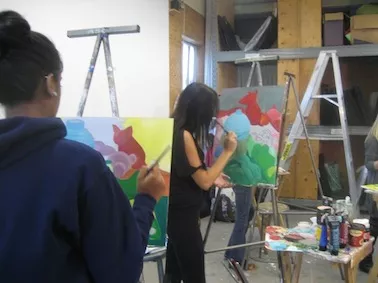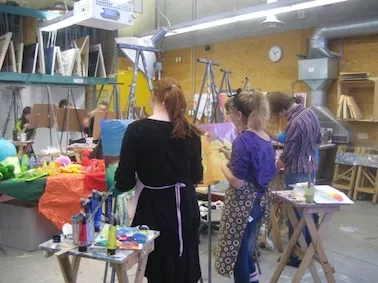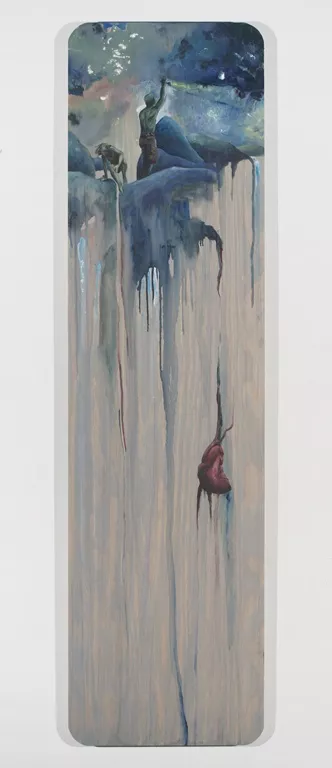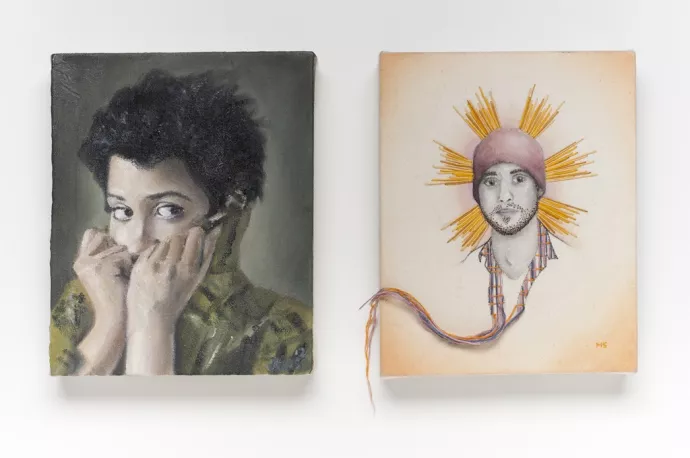In Painting 1 through Painting 4, students work to develop an understanding of various codes of painting, to chart how these codes have shifted historically, and to discover how this knowledge may be applied to their own work. Our hope is that graduates will make sophisticated and highly personal paintings, as well as have a sense of how their paintings, as vehicles of communication, may be interpreted.



Photos: Painting 1 (2012). Courtesy of Moira Clark.
Painting 1
Course Objectives
To develop direct (single-application) painting skills through recording observed motifs or addressing set problems within a given length of time.
To acquaint the student with contemporary approaches to the medium through:
- exploration of the formal properties of colour, tone and composition
- use of traditional and non-traditional painting materials
- experimentation in deriving imagery from both an observed motif — such as landscape, the figure, still life, a mechanical reproduction and text — and from processes of collage and abstraction
Class Structure
Each week students complete in-class studio assignments augmented by technical demonstrations and brief slide presentations. Approximately every four weeks, a short group critique is held in order to view and discuss projects done outside of class or studio assignments, or both. Students maintain a sketchbook/notebook, which will include reviews of visiting artist presentations and exhibitions.
Through problem-based learning, students are introduced to the following techniques and skills:
- use of acrylic paint and various mediums, such as Rhoplex, gel medium, impasto medium
- analysis of form and light using analytical techniques such as divided brushstroke, interlocking geometrical planes, continuous modeling, and so on
- painting techniques, such as drybrush, glazing, staining, impasto, wet-into-wet colour mixing and modulation of hue, value and saturation
- the use of assorted painting tools
- the use and construction of painting supports and grounds, such as paper, hardboard, stretched canvas, collage and mixed media, gesso or Rhoplex
- critical awareness of the values associated with their choice of imagery

On completion of the course students should have explored the following:
- paint as a descriptive and expressive tool
- aspects of historical and contemporary art practices
Painting 2
Course Objectives
To introduce students to research and planning prior to the realization of a sustained painting, as well as to expand students' ideas of possible sources for their paintings. Students are introduced to additional painting techniques and media, as well as to a diverse range of historical and contemporary artists' practices. In turn, students are encouraged to develop a greater sense of creating "their own work."
Course Structure
Within a format of three-week projects, students research and develop preparatory sketches to create paintings that use indirect painting techniques (over-painting). Students' artworks are discussed on a one-to-one basis and in class critiques where students and the instructor share the responsibility for developing a community of open and constructive debate.
Projects investigate painting's traditional genre within the context of a contemporary understanding of symbol and metaphor. Project topics include the following: landscape, still life, interior, narrative, printed or off-set imaging, pop cultural sources, and the development of a series of three paintings.
Students maintain a sketchbook/notebook, which will include reviews of visiting artist presentations and exhibitions. Additionally, students critically present the work of an assigned contemporary artist in a class seminar.
Through problem-based learning, students are introduced to or continue to explore the following techniques and skills:
- use of oil paint, encaustic, cold wax, gouache, lettering enamel
- the use and construction of a variety of painting supports, such as paper, hardboard, stretched canvas, collage and mixed media, etc.
On completion of the course students should have achieved greater expertise in the following:
- solving pictorial and conceptual problems through research, application and resolution preparing to more independently generate their own ideas Photo: Painting 3; Denise Juckers: Search with Heart (2010).
- painting skill and execution
- editing and presentation of paintings within the context of an exhibition
- the ability to articulate and critically assess their own work and the work of their peers
- understanding of historical and contemporary art practices
Painting 3
Course Objectives
Students are encouraged to develop an area of personal artistic research informed both by their own enthusiasms and interests as well as by their understanding of the works of other artists. Students reinforce their painting vocabulary, and begin to produce self-directed work.
Class Structure
In the first term, students continue to work within the parameters of broadly interpretive assignments that stress research and the combination of various sources. Short slide presentations, assigned readings, gallery excursions, and technical demonstrations may augment classes. Students maintain a sketchbook/notebook, which will include reviews of visiting artist presentations and exhibitions. Additionally, students critically present the work of an assigned contemporary artist in a class seminar. Class critiques occur on a two-week cycle.
Students are introduced to the following ideas and skills:
- theoretical ideas in contemporary painting; students are invited to explore aspects of modernity and postmodernity, such as uniqueness, authorship and originality
- documentation of artwork, artist statements, application writing, further education, and career opportunities
On completion of the course students should have achieved greater expertise in the following:
- understanding of historical and contemporary art practices preparing to generate their ideas independently
- skill in the execution of their artwork
- solving pictorial and conceptual problems through research, application and resolution
- articulating and critically assessing their own work and the work of their peers
- photographic documentation of their own artworks
- understanding of the editing and presentation of paintings within the context of a collaborative exhibition

Painting 4
Course Objectives
Students continue to develop an area of personal artistic research informed both by their own enthusiasms and interests as well as by their understanding of contemporary painting practices. Students produce a body of self-directed work, and present this work in a graduating exhibition.
Class Structure
Class critiques occur on a two-week cycle. Short slide presentations, assigned readings, gallery excursions, and technical demonstrations may augment classes. Students are asked to critically present the work of an assigned contemporary artist in a class seminar. Students maintain a sketchbook/notebook, which will include reviews of visiting artist presentations and exhibitions. Additionally, students critically present the work of an assigned contemporary artist in a class seminar.
Photo: Painting 4, Daniel Deus: Plaid Portrait Exchange with Melina Sevilla (2011).
Students are introduced to the following ideas and skills:
- theoretical ideas in contemporary painting; students are invited to explore aspects of modernity and postmodernity, such as uniqueness, authorship and originality
- documentation of artwork, artist statements, application writing, further education, and career opportunities
On completion of the course students should have achieved greater expertise in the following:
- understanding of historical and contemporary art practices preparing to generate their ideas independently
- skill in the execution of their artwork
- solving pictorial and conceptual problems through research, application and resolution
- articulating and critically assessing their own work and the work of their peers
- photographic documentation of their own artworks
- understanding of the editing and presentation of paintings within the context of a collaborative exhibition
